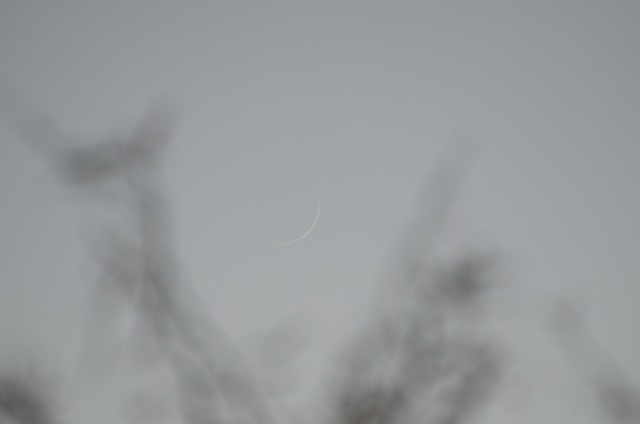
Venus-Moon Conjunction
Posted: 27 November 2011
Opened the observatory Saturday, 26 November, at 1709 MST, 68°F. The sky was clear but there was a strong breeze blowing. During the daytime, the wind had been blowing with gusts to 30 MPH. The dome was opened a few minutes before local sunset. At 1713 MST, I took a quick look at the crescent moon with the 8" LX200-ACF at 77X. This photo, taken with the Nikon D7000 DSLR at f/6.3, 1/640sec, 300mm, ISO 500, shows what the moon looked like in the sky:

I mounted the iPhone 4 on the telescope with the MX-1 afocal adapter and took this (cropped) image at 77X:

Venus and the crescent moon made a nice conjunction low in the western sky shortly after sunset. This is a (cropped) photo taken with the D7000, f/14, 1/30sec, 70mm, ISO 1600:

At 1751 MST, I took this photo of the observatory, Venus, and the moon with the iPhone 4:

At 1802 MST, I took this photo, D7000, f/5.6, 1/60sec, 300mm, ISO 1600, showing Venus, the crescent moon, and Earthshine:

Beginning at 1820 MST, I did some lunar observing at 77X. There was a nice view of Earthshine in the telescope. Then I took a quick look at Venus. At 1830 MST, slewed to Jupiter and began viewing it at 77X. Four moons were visible. Switched to 206X with moon filter; the Great Red Spot (GRS) would be visible in a few minutes. Unfortunately, seeing was not very good. At 1843 MST, switched to the 133X (no moon filter); I could just detect the GRS well away from Jupiter's limb. It was about an hour before central meridian crossing. Seeing continued to be lousy, but the humidity was a lot less than on the previous night. It was currently about 20% (versus 65% on the previous night). I added the moon filter to the 15mm (133X) eyepiece, which helped viewing somewhat.
At 1900 MST, I began setting up for D7000 DSLR imaging of Jupiter at prime focus + 3X TeleXtender. Unfortunately, seeing remained bad, but at least I could do some test exposures for future reference. I did 1 minute video recordings at 1/200sec, ISO 1600; 1/250sec ISO 2000; and 1/250sec ISO 3200. Jupiter danced around a lot while recording. The best exposure for stacking was 1/250sec ISO 3200, but was still slightly underexposed. This is a stack of 1064 frames from the D7000 HD video recording:

The GRS is barely visible to the right of the central meridian in the South Equatorial Belt (SEB) in this correct orientation image.
At 1930 MST, I resumed viewing Jupiter at 133X (with moon filter). The breezes were getting stronger. At 1940 MST, I switched to the 9.7mm (206X) eyepiece (no moon filter); the Great Red Spot and its little brother were quite distinct during brief moments of steady seeing. I added the moon filter, which reduced the glare.
I ended Jupiter observing at 1950 MST and slewed to M31 (Andromeda Galaxy) for view at 77X. Then it was to NGC891, a faint edge-on galaxy, also in the constellation of Andromeda. It was a nice but difficult object to view. I then viewed M45 (Pleiades); blue-ish nebulosity easily seen around many of its stars. I then viewed M1 (Crab Nebula), still low in the east. At 2007 MST, I began a tour of DSOs in the constellation of Cetus: NGC246 (planetary nebula), NGC247 (spiral galaxy), Caldwell 51 (irregular galaxy), and M77 (galaxy).
At 2027 MST, I returned to Jupiter for a quick look at 77X. I then took a short break while waiting to see if the wind would die down. I closed the dome to keep loose papers inside the observatory from flying around. I returned to the observatory at 2057 MST, although the wind was still blowing. I opened the dome at 2108 MST and viewed Jupiter at 206X (with moon filter). The GRS was rotating out of view. The moon Io was approaching the planet for its upcoming transit. However, due to the strong breezes that were still blowing and the poor seeing, I decided to close up for the night.
Closed the observatory at 2125 MST, 50°F, humidity 21%.
I recently started a "Lighting Hall of Shame" web page to "honor" some sources of light pollution and light nuisance. Check it out.
Go to the previous report.
Return to the Cassiopeia Observatory Welcome Page.